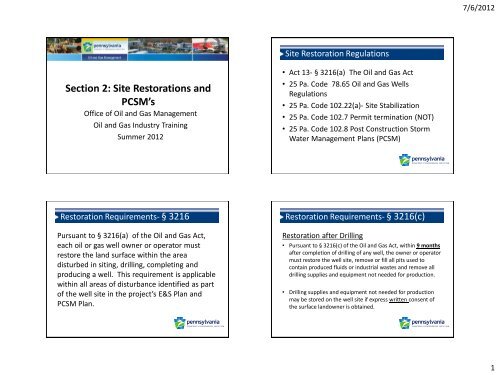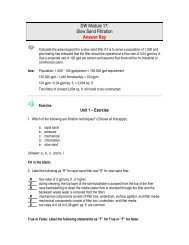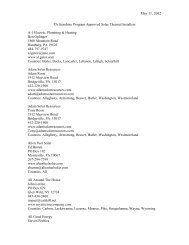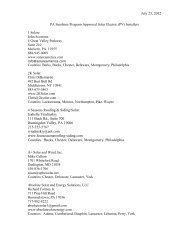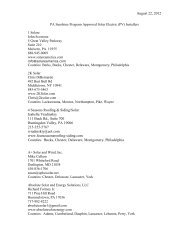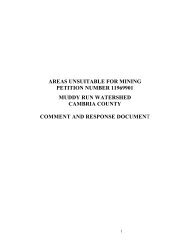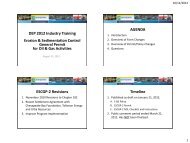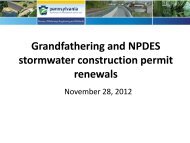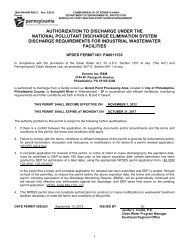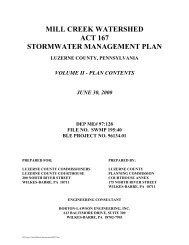Section 2: Site Restorations and PCSM's
Section 2: Site Restorations and PCSM's
Section 2: Site Restorations and PCSM's
You also want an ePaper? Increase the reach of your titles
YUMPU automatically turns print PDFs into web optimized ePapers that Google loves.
<strong>Section</strong> 2: <strong>Site</strong> <strong>Restorations</strong> <strong>and</strong><br />
PCSM’s<br />
Office of Oil <strong>and</strong> Gas Management<br />
Oil <strong>and</strong> Gas Industry Training<br />
Summer 2012<br />
Restoration Requirements- § 3216<br />
Pursuant to § 3216(a) of the Oil <strong>and</strong> Gas Act,<br />
each oil or gas well owner or operator must<br />
restore the l<strong>and</strong> surface within the area<br />
disturbed in siting, drilling, completing <strong>and</strong><br />
producing a well. This requirement is applicable<br />
within all areas of disturbance identified as part<br />
of the well site in the project’s E&S Plan <strong>and</strong><br />
PCSM Plan.<br />
<strong>Site</strong> Restoration Regulations<br />
• Act 13- § 3216(a) The Oil <strong>and</strong> Gas Act<br />
• 25 Pa. Code 78.65 Oil <strong>and</strong> Gas Wells<br />
Regulations<br />
• 25 Pa. Code 102.22(a)- <strong>Site</strong> Stabilization<br />
• 25 Pa. Code 102.7 Permit termination (NOT)<br />
• 25 Pa. Code 102.8 Post Construction Storm<br />
Water Management Plans (PCSM)<br />
Restoration Requirements- § 3216(c)<br />
Restoration after Drilling<br />
• Pursuant to § 3216(c) of the Oil <strong>and</strong> Gas Act, within 9 months<br />
after completion of drilling of any well, the owner or operator<br />
must restore the well site, remove or fill all pits used to<br />
contain produced fluids or industrial wastes <strong>and</strong> remove all<br />
drilling supplies <strong>and</strong> equipment not needed for production.<br />
• Drilling supplies <strong>and</strong> equipment not needed for production<br />
may be stored on the well site if express written consent of<br />
the surface l<strong>and</strong>owner is obtained.<br />
7/6/2012<br />
1
Defining Completion of Drilling- § 3216(c)<br />
• Particular attention should be paid to the fact<br />
that the 9 month restoration period begins<br />
after total depth (TD) is reached which is the<br />
date of the completion of drilling.<br />
• Hydraulic Fracturing, flow back periods, <strong>and</strong><br />
other related well completion activities are<br />
not defined as drilling activities.<br />
Restoration of Centralized Impoundments<br />
• Post drilling restoration includes the<br />
restoration of any centralized wastewater or<br />
freshwater impoundments.<br />
• Centralized impoundments must be restored<br />
within 9 months after the final well serviced<br />
by the impoundment is drilled or the last valid<br />
permit has expired.<br />
Restoration <strong>and</strong> Multi-Well Pads<br />
When multiple wells are drilled on a single well<br />
site, the Department interprets §3216 of Act 13<br />
The Oil <strong>and</strong> Gas Act to mean that post drilling<br />
restoration is required within 9 months after<br />
completion of drilling of all permitted wells on<br />
the well site <strong>and</strong>/or the expiration of all existing<br />
well permits on the well site, whichever occurs<br />
later in time.<br />
Restoration of Borrow Pits<br />
• Restoration of Borrow Pits is not required<br />
until 9 months after the final well<br />
serviced with material obtained from the<br />
borrow pit is drilled or the last valid<br />
permit has expired.<br />
7/6/2012<br />
2
• Pursuant to § 3216(d) of the Oil <strong>and</strong> Gas<br />
Act, within 9 months after plugging a<br />
well, the owner or operator shall remove<br />
all production or storage facilities,<br />
supplies <strong>and</strong> equipment <strong>and</strong> restore the<br />
well site.<br />
.<br />
Restoration after Plugging<br />
Restoration <strong>and</strong> PCSM Plans<br />
• Under to 25 Pa. Code § 102.8(n), the portion<br />
of a site restoration plan that identifies PCSM<br />
BMPs to manage stormwater from Oil <strong>and</strong> Gas<br />
Activities permitted in accordance with<br />
Chapter 78 may be used to satisfy § 102.8’s<br />
PCSM Plan requirements if the PCSM/<strong>Site</strong><br />
Restoration Plan meet the requirements of<br />
§ 102.8 <strong>and</strong> the following 8 subsections:<br />
Restoration after Plugging- Multiple Wells<br />
• When multiple wells are plugged on a<br />
single well site, the Department<br />
interprets § 3216 of the Oil <strong>and</strong> Gas Act<br />
to mean that the 9 month timeframe for<br />
permanent restoration begins after<br />
plugging the final well on that site.<br />
Restoration <strong>and</strong> PCSM Plans<br />
(b) General PCSM planning <strong>and</strong> design-<br />
1. Preserve the integrity of stream channels <strong>and</strong><br />
maintain <strong>and</strong> protect the physical, biological<br />
<strong>and</strong> chemical qualities of the receiving stream<br />
2. Prevent an increase in the rate of stormwater<br />
runoff.<br />
3. Minimize any increase in stormwater runoff<br />
volume.<br />
4. Minimize impervious areas.<br />
7/6/2012<br />
3
Restoration <strong>and</strong> PCSM Plans<br />
(b) General PCSM planning <strong>and</strong> design- (cont.)<br />
5. Maximize the protection of existing drainage<br />
features <strong>and</strong> existing vegetation.<br />
6. Minimize l<strong>and</strong> clearing <strong>and</strong> grading.<br />
7. Minimize soil compaction<br />
8. Utilize other structural or nonstructural<br />
BMP’s that prevent or minimize changes in<br />
stormwater runoff.<br />
Restoration <strong>and</strong> PCSM Plans<br />
(e) PCSM Plan preparer requirements- The<br />
PCSM plan must be prepared by a person<br />
trained <strong>and</strong> experienced in PCSM design<br />
methods.<br />
(f) PCSM Plan contents- The PCSM Plan must<br />
contain drawings <strong>and</strong> a narrative consistent with<br />
the requirements of Chapter 102. (See Chapter<br />
102.8(f) for details).<br />
Restoration <strong>and</strong> PCSM Plans<br />
(c) Consistency with existing E&S Plan- The<br />
PCSM Plan must be planned, designed <strong>and</strong><br />
implemented to be consistent with the<br />
existing E&S Plan. The plans should not<br />
contradict one another.<br />
Restoration <strong>and</strong> PCSM Plans<br />
(h) PCSM Implementation for special protection waters-<br />
To satisfy the anti-degradation implementation<br />
requirements in 93.4c(b) the permitee must evaluate<br />
non-discharge alternatives unless non-discharge<br />
alternatives do not exist for the project. If nondischarge<br />
alternatives do not exist ABACT BMP’s should<br />
be implemented as listed in the Pennsylvania<br />
Stormwater Best Management Practices Manual No.<br />
363-0300-002.<br />
7/6/2012<br />
4
Restoration <strong>and</strong> PCSM Plans<br />
(i) Complaint or site inspection- Upon<br />
complaint or site inspection, the<br />
Department or conservation district may<br />
require that the PCSM Plan be submitted<br />
for review <strong>and</strong> approval to ensure<br />
compliance with this chapter.<br />
Restoration <strong>and</strong> PCSM Plans<br />
(m) PCSM long-term operation <strong>and</strong> maintenance<br />
requirements (when applicable)<br />
• Generally this section ensures that long-term PCSM<br />
are maintained by the permitee or co-permitee or<br />
<strong>and</strong> that they are responsible to record an<br />
instrument with the recorder of deeds which will<br />
assure that the long-term PCSM BMP’s are managed<br />
into the future indefinitely. (See Chapter 102.8(m)<br />
for a more detailed explanation)<br />
Restoration <strong>and</strong> PCSM Plans<br />
(l) Final Certification- The permitee shall<br />
include with the notice of termination<br />
“Record Drawings” with a final certification<br />
statement from a licensed professional.<br />
(See Chapter 102.8(l) for the final<br />
certification statement verbatim)<br />
When is a site restored?<br />
The Department considers a well site to be<br />
restored under § 3216 of Act 13 when the<br />
operator meets the following criteria:<br />
• All permanent post construction stormwater<br />
control features as identified in the PCSM/<strong>Site</strong><br />
Restoration Plan are in place.<br />
7/6/2012<br />
5
When is a site restored?<br />
• Remaining impervious areas are minimized.<br />
See 25 Pa. Code § 102.8(b)(4). Impervious<br />
areas include but are not limited to areas<br />
where the soil has been compacted, areas<br />
where the soil has been treated with<br />
amendments to firm or harden the soil <strong>and</strong><br />
areas where soil is underlain with a synthetic<br />
or other type of impermeable liner.<br />
Areas needed for production?<br />
a. Areas used for truck access (area should<br />
be no larger than needed for trucks to<br />
access the site <strong>and</strong> turn around to leave<br />
the site)<br />
b. Areas used for storage tanks <strong>and</strong><br />
secondary containment facilities<br />
c. Area used for well head(s) <strong>and</strong><br />
appurtenant processing facilities<br />
When is a site restored?<br />
All areas of the site not needed for<br />
production are restored to approximate<br />
original conditions including<br />
preconstruction contours <strong>and</strong> l<strong>and</strong> uses.<br />
The Department considers the following<br />
areas as needed for production:<br />
Areas needed for production?<br />
d. Area used for any necessary safety<br />
buffer<br />
e. Area used to store any supplies or<br />
equipment consented to by the surface<br />
l<strong>and</strong> owner<br />
f. Area used for implementation <strong>and</strong><br />
management of long term PCSM BMPs<br />
7/6/2012<br />
6
Areas needed for production?<br />
• Pursuant to 25 Pa. Code § 102.8(m)(1) the<br />
permitee or co-permitee shall be responsible<br />
for long-term operation <strong>and</strong> maintenance of<br />
PCSM BMPs unless a different person is<br />
identified in the Notice of Termination <strong>and</strong> has<br />
agreed to long-term operation <strong>and</strong><br />
maintenance of the PCSM BMPs.<br />
• Long Term Responsibility for the maintenance<br />
for PCSM BMP’s shall be recorded in the deed.<br />
What else needed for Restoration?<br />
Restoration Plan Drawings<br />
• Areas needed for production <strong>and</strong> the proposed final<br />
site layout including driveways, storage tanks,<br />
locations of wellheads <strong>and</strong> appurtenant gas<br />
processing facilities, safety buffer, equipment<br />
consented to by the surface owner <strong>and</strong> permanent<br />
PCSM BMPs should be shown on the site restoration<br />
plan drawings. The site should be organized in the<br />
most spatially efficient manner practicable to<br />
minimize any unrestored area.<br />
What else needed for Restoration?<br />
70% Perennial Vegetative Cover<br />
• The disturbed area is covered with a minimum<br />
uniform 70% perennial vegetative cover with a<br />
density capable of resisting accelerated erosion <strong>and</strong><br />
sedimentation or an acceptable BMP which<br />
permanently minimizes accelerated erosion <strong>and</strong><br />
sedimentation.<br />
• (See DEP Erosion <strong>and</strong> Sedimentation Control Manual<br />
for details on determining appropriate vegetative<br />
cover)<br />
Restoration Extensions?<br />
According to 3216 the current 9 month well site<br />
restoration requirement may be extended by<br />
the department for an additional 2 years upon a<br />
determination of the following:<br />
– The extension will result in less earth disturbance,<br />
increased water reuse or more efficient<br />
development of the resource; or<br />
– <strong>Site</strong> restoration cannot be achieved due to<br />
adverse weather conditions or a lack of essential<br />
fuel, equipment or labor<br />
7/6/2012<br />
7
Restoration Extensions:<br />
If a demonstration is made that an<br />
extension will result in less earth<br />
disturbance, increased water reuse or<br />
more efficient development of the<br />
resource, the operator shall do all of<br />
the following:<br />
Restoration Extensions:<br />
Provide a site restoration plan that provides for<br />
the following: (cont.)<br />
• Stabilization of the well site, including<br />
post-construction storm water<br />
management best management<br />
practices; or<br />
• Other measures to minimize accelerated<br />
erosion <strong>and</strong> sedimentation<br />
Restoration Extensions:<br />
Provide a site restoration plan that<br />
provides for the following:<br />
• Timely removal or fill of all pits used<br />
to contain fluids or industrial wastes;<br />
• Removal of all drilling supplies <strong>and</strong><br />
equipment not needed for<br />
production;<br />
Restoration Extensions: (cont.)<br />
– Provide for returning portions of the<br />
site not occupied by production or<br />
equipment to approximate original<br />
contours capable of supporting predrilling<br />
existing uses<br />
7/6/2012<br />
8
Well <strong>Site</strong> Restoration Reports- OG-0075<br />
• Pursuant to 25 Pa. Code § 78.65(3), within 60 days<br />
after the restoration of the well site, the operator<br />
must submit a well site restoration report to the<br />
Department. Refer to Appendix B for copy of<br />
OG0075.<br />
• The Department considers a well site to be under<br />
construction until the Department receives the well<br />
site’s restoration report.<br />
What should be reviews- OG-0075 ‘s<br />
• Have all of the pits been restored properly?<br />
• If cuttings were encapsulated are the signs<br />
on the surface that the free liquid fraction<br />
was not adequately removed as required in<br />
25 Pa. Code § 78.61(a)(6) <strong>and</strong> § 78.62(a)(14)<br />
• Ensure that the pit is backfilled to at least<br />
18” over the top of the liner <strong>and</strong> graded to<br />
promote runoff <strong>and</strong> no depressions.<br />
Who reviews- OG-0075 ‘s<br />
• Who reviews OG0075’s? – In most cases, the<br />
Water Quality Specialist will review <strong>and</strong> field<br />
verify the accuracy of the OG-75 before<br />
signing off on the Well <strong>Site</strong> Restoration<br />
Report. A signed copy should be provided to<br />
the operator <strong>and</strong> one copy should be kept in<br />
each well permit file.<br />
What should be reviewed- OG-0075 ‘s<br />
• Ensure that the surface area of the backfilled<br />
pit area is revegetated, or stabilized in another<br />
manner, to protect against excessive erosion.<br />
• Ensure that all appropriate testing is done on<br />
the leachate as required by 25 Pa. Code<br />
§ 78.62(b).<br />
7/6/2012<br />
9
Is everybody doing this? - OG-0075 ‘s<br />
Leachate testing of cuttings:<br />
• The test results should be evaluated by the WQS or in<br />
some cases a Solid Waste Management Specialist.<br />
• does not exceed 50% of the maximum concentration<br />
in § 261.24 Table 1 (relating to characteristic of<br />
toxicity)<br />
• 50 times the primary maximum contaminant level in<br />
effect under § 109.202 (relating to state maximum<br />
contaminant levels)<br />
• See Appendix C- for Table 1 <strong>and</strong> Primary MCL’s.<br />
ESCGP Permit Termination (NOT)<br />
According to 25 Pa. Code § 102.7, upon<br />
completion of post drilling restoration or<br />
permanent restoration of the well site<br />
Permitee must submit a notice of<br />
termination to the Department. The notice<br />
of termination must include the following:<br />
Restoration when well is not drilled<br />
Pursuant to 25 Pa. Code § 78.65(2) if a well site<br />
is constructed <strong>and</strong> the well is not drilled, the<br />
well site shall be restored within 30 days after<br />
the expiration of the well permit unless the<br />
Department approves an extension application<br />
by the well owner or operator for reasons of<br />
adverse weather or lack of essential fuel,<br />
equipment or labor.<br />
What should be included in the (NOT)<br />
1. The facility name, address <strong>and</strong> location.<br />
2. The operator name <strong>and</strong> address.<br />
3. The permit number.<br />
4. The reason for permit termination.<br />
5. Identification of the persons who have agreed to<br />
<strong>and</strong> will be responsible for long-term operation <strong>and</strong><br />
maintenance of the PCSM BMPs in accordance with<br />
25 Pa. Code § 102.8(m) <strong>and</strong> proof of compliance with<br />
25 Pa. Code § 102.8(m)(2) (when applicable).<br />
7/6/2012<br />
10
DEP Approval of the (NOT)<br />
• Until the permitee or co-permitee has<br />
received written approval of a notice of<br />
termination, the permitee or co-permitee will<br />
remain responsible for compliance with the<br />
permit terms <strong>and</strong> conditions including longterm<br />
operation <strong>and</strong> maintenance of all PCSM<br />
BMPs on the project site <strong>and</strong> is responsible for<br />
violations occurring on the project site.<br />
DEP Approval of the (NOT)<br />
*Inspection Point- The WQS will typically<br />
conduct these inspections to ensure that the<br />
Restoration/PCSM Plan has been implemented.<br />
In order for the NOT to be granted by the<br />
Department the WQS will ensure that all Well<br />
<strong>Site</strong> Restoration Reports for each well pad/site<br />
has been received <strong>and</strong> approved for all well pads<br />
included in the project.<br />
DEP Approval of the (NOT)<br />
• The Department or conservation<br />
district will conduct a final inspection<br />
<strong>and</strong> approve or deny the notice of<br />
termination within 30 days.<br />
Earth Disturbance after Restoration<br />
Scenario #1: After an OG0075 is submitted, reviewed,<br />
<strong>and</strong> signed by the WQS the operator needs to go back<br />
<strong>and</strong> disturb soil in or around the well pad. The<br />
operator can do this provided that requirements of<br />
Chapter 102 are followed. If more than 5,000 ft 2 are<br />
disturbed an E&S plan must be prepared <strong>and</strong> followed<br />
(The original E&S plan may suffice provided that it is<br />
updated to reflect any relevant changes like disturbed<br />
area, changes in BMP’s, runoff calculations, etc…) This<br />
would apply for sites < 5 acres or if ESCGP still valid.<br />
7/6/2012<br />
11
Earth Disturbance after Restoration<br />
*Inspection Point- Once the Department<br />
approves a submitted NOT the permit is officially<br />
terminated. If the operator needs to go back in<br />
they are starting from scratch <strong>and</strong> will have to<br />
apply for a new permit if the disturbed area ≥ 5<br />
acres. If more than 5,000 ft 2 but < 5 acres only<br />
an E&S plan needs to be prepared in accordance<br />
with Chapter 102 <strong>and</strong> the E&S Manual.<br />
Kirk K. Elkin<br />
Mineral Resources Program Specialist<br />
Bureau of Regulatory & Resources Enhancement<br />
Office of Oil <strong>and</strong> Gas Management<br />
310 Best Avenue<br />
Knox, PA 16232<br />
v 814.779.1272<br />
F 814.797.0872<br />
e-mail-kelkin@pa.gov<br />
7/6/2012<br />
12


